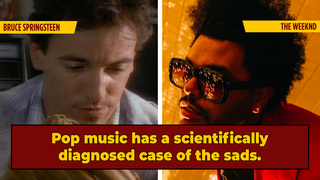Surprise, Surprise: Pop Music is Getting Sadder

Apparently, a bunch of old old farts recently started wondering why today's music is so sad and angry, but unlike most of their suspicions regarding the kids these days, it turns out they were right. A bunch of different studies have analyzed everything from the lyrics to the density of minor versus major chords in songs from the '50s and '60s through about 2015-ish. They've all shown the same thing: Starting around the '80s, sadness, anger, fear, and other negative emotions became way more common in pop music, while joy and confidence sharply declined, Demi Lovato notwithstanding.
Their methodology is somewhat suspect -- for example, one study found "Glory Days'' by Bruce Springsteen to be a joyful song ...
... but assuming most aren't biting satire, the average pop song today is actually more aggressive than any given '70s punk song.
There's a number of possible explanations for this. Several of the studies' authors suggest that the changing social and political landscape has influenced songwriters, but it does seem like there might have been politics in the '60s, too. Maybe a war thing? You'd think someone would have written a song about that. One writer suggested that the assembly line method of songwriting involving entire armies of songwriters that became popular in the '90s are more likely to write not from personal experience but in an attempt to gauge the mood of the public, and it's hard to argue that the public doesn't generally demand apologies from Justin Bieber.
According to a pair of anthropologists who ran a battery of bias tests, it seems most likely that it just happened by chance and then became a thing, like everyone naming their babies Jayden. Interestingly, while expressions of negative emotions have increased, the "danceability" of your average pop song has gone way up.
We're all just trying to dance our sadness out.
Manna, regrettably, has a Twitter.
Top image: Columbia Records, XO/Republic Records